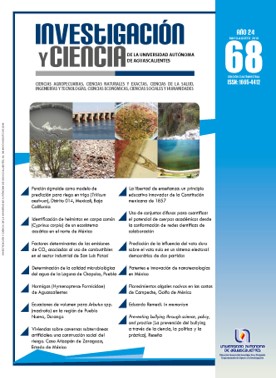Assessment of the microbial quality of Chapulco Lagoon, Puebla
DOI:
https://doi.org/10.33064/iycuaa2016681952Keywords:
Chapulco, bacteria, water, E.coli, Salmonella sp., Shigella sp.Abstract
In the city of Puebla there are six principal water bodies and Chapulco Lagoon is one of them, however lagoon water could face pathogen pollution problems. Three independent samples were taken at 10 sectioned points of Chapulco Lagoon, the samples were inoculated in SS Agar culture media for the selective isolation of Salmonella sp., Shigella sp. and the coliforms in the media EMB. The presence of Escherichia coli was determined with a maximum value of 3 x 105 CFU/ml that exceeds the limit allowed for NOM-003-ECOL-1997. The microorganisms Shigella sp. and Salmonella sp. presented a maximum value of 2 x 10 3 CFU/ml and 8 x 10 6 CFU/ml, respectively.
Downloads
References
• BARRERA ESCORCIA, G. et al. La sensibilidad del grupo coliforme como indicador de la presencia de enterobacterias patógenas en cuatro cuerpos acuáticos de México. Hidrobiológica, 23(1): 87-96, 2013.
• DEL PILAR, M. et al. Microbiological indicators of contamination of the water sources. NOVA-Publicación Científica, 3(4): 69-79, 2005.
• FARNLEITNER, A. H. et al. Escherichia coli and enterococci are sensitive and reliable indicators for human, livestock and wildlife faecal pollution in alpine mountainous water resources. Journal of Applied Microbiology, 109(5): 1599-1608, 2010.
• GONZÁLEZ, A. M. et al. Relationships between fecal indicators and pathogenic microorganisms in a tropical lagoon in Rio de Janeiro, Brazil. Environmental Monitoring and Assessment, 164(1): 207-219, 2010.
• HARWOOD, V. J. et al. Validity of the indicator organism paradigm for pathogen reduction in reclaimed water and public health protection. Applied and Environmental Microbiology, 71(6): 3163-3170, 2005.
• LAMENDELLA, R. et al. Bifidobacteria in feces and environmental waters. Applied and Environmental Microbiology, 74(3): 575-584, 2008.
• LARREA, J. et al. Evaluación de la calidad microbiológica de las aguas del Complejo Turístico Las Terrazas, Pinar del Río (Cuba). Higiene y Sanidad Ambiental, 9, 492-504, 2009.
• LUNA PABELLO, V. M. y ABURTO CASTAÑEDA, S. Sistema de humedales artificiales para el control de la eutroficación del lago del Bosque de San Juan de Aragón. Tip Revista Especializada en Ciencias Químico-Biológicas, 17(1): 32-55, 2014.
• RIVERA, R. et al. Relations fecal coliforms/fecal streptococci as indicators of the origin of fecal pollution in urban and rural water bodies of Temuco, Chile. Ciencia e Investigación Agraria, 37(2): 141-149, 2010.
• SAVICHTCHEVA, O. y OKABE, S. Alternative indicators of fecal pollution: relations with pathogens and conventional indicators, current methodologies for direct pathogen monitoring and future application perspectives. Water Research, 40(13): 2463-2476, 2006.
• SEMARNAT (SECRETARÍA DE MEDIO AMBIENTE, RECURSOS NATURALES Y PESCA). NORMA OFICIAL MEXICANA NOM-003-ECOL-1997, Que establece los límites máximos permisibles de contaminantes para las aguas residuales tratadas que se reúsen en servicios al público. Diario Oficial de la Federación, 21 de septiembre de 1998.
• WINFIELD, M. D. y GROISMAN, E. A. Role of Non host Environments in the Life styles of Salmonella and Escherichia coli. Applied and Environmental Microbiology, 69(7): 3687-3694, 2003.
De páginas electrónicas
• GOBIERNO MUNICIPAL DE PUEBLA. Plan Municipal de Desarrollo 2011-2014. 2015. Recuperado de implanpuebla.gob.mx/sitio/wp-content/uploads/2015/03/PMD_2011_2014.pdf
• INEGI (INSTITUTO NACIONAL DE ESTADÍSTICA Y GEOGRAFÍA). Anuario de estadísticas por entidad federativa 2011. 2011. Recuperado de centro.paot.org.mx/documentos/inegi/anuario_esta_federativa_2011.pdf
• SARH (SECRETARÍA DE AGRICULTURA Y RECURSOS HIDRÁULICOS) et al. NORMA MEXICANA NMX-AA-3-1980. Norma Mexicana Aguas Residuales. - Muestreo. Legismex. Legislación ambiental mexicana [Folleto electrónico]. Recuperado de http://legismex.mty.itesm.mx/normas/aa/aa003.pdf
• SSA (SECRETARÍA DE SALUD). Norma Oficial Mexicana NOM-112-SSA1-1994, Bienes y servicios. Determinación de bacterias coliformes. Técnica del número más probable. Diario Oficial de la Federación, 10 de mayo de 1995. Recuperado de http://www.salud.gob.mx/unidades/cdi/nom/112ssa14.html
Downloads
Published
How to Cite
License
Las obras publicadas en versión electrónica de la revista están bajo la licencia Creative Commons Atribución-NoComercial-CompartirIgual 4.0 Internacional (CC BY-NC-SA 4.0)









